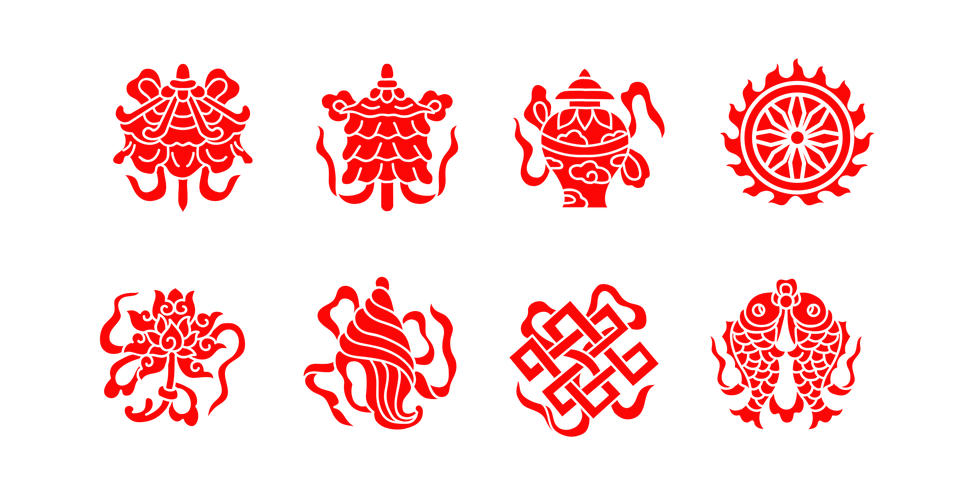Ashtamangala, Sanskrit for Eight Auspicious, are symbols that point to qualities of mind. They are also referred to as bkra-shis-rtags brgyad. The symbols are supposed to bring good fortune when they come across. The eight symbols are usually displayed in a certain order by Buddhists. The order is:
1. The Endless Knot:
Represented by many things. Usually, they have intertwined snakes or the naga symbol. Likewise, the knot represents many different things. It can represent: The joining of opposing forces to bring harmony to the universe, the joining of wisdom and method, of wisdom and compassion, and the dependence of religion and secularism. Since the knot is endless, it also represents the never-ending wisdom of the Buddha.
2. The Lotus Flower:
Since the lotus does not grow in the area where Buddhism originally started, the artwork features stylized versions of the flower. In Buddhist art, the flower is seen stemming from the mud, with a god sitting on it or holding one up.
 This represents the path of the soul through the mud of materialism to the experience in the water and finally into the enlightenment of the sun. It is also symbolic of good deeds blossoming. It is one of the most recognizable of the Eight Auspicious Symbols.
This represents the path of the soul through the mud of materialism to the experience in the water and finally into the enlightenment of the sun. It is also symbolic of good deeds blossoming. It is one of the most recognizable of the Eight Auspicious Symbols.
3. The Victory Banner:
The banner is like those carried by ancient Indian generals to war. It was then adopted by Buddhists as a banner that signified the Buddha’s victory over ignorance. It also stands for the triumph of the mind and body over negative hindrances. Today, the banners are placed in each of the four corners of temples or monasteries.
4. The Wheel of Dharma:
Resembling a wheel with eight spokes, it is also represented by a simple circle. Since the circle is a perfect form and shape, it comes to symbolize the perfection of Buddha.
5. The Treasure Vase:
Also called the Urn of Wisdom, it resembles a pot-bellied jar with a short neck. On top of its lid is a precious jewel that indicates that the vase contains great treasure. It represents wealth, good health, and wisdom. It also symbolized space, which holds everything that is.
6. The Golden Fish:
Two fishes facing each other. It can represent the two Indian rivers, Ganga and Yamuna, which in turn symbolize the solar and lunar cycles. The fishes also represent happiness, since they are free of worries in the water.
7. The Parasol:
It is an umbrella or canopy protecting beings from danger and evil. It is also symbolic of the sky or firmament above us and its expansiveness. The parasol provides the shade of protection against the heat of suffering.
8. The Shankha:
A white conch-shell that turns to the right. Indian legends have many heroes who carried a shell into battle. To Buddhists, the shell represents the sound made by Buddhadharma, which is beautiful, deep and peaceful. When blown, the shell is supposed to awaken disciples from ignorance and pushes them to work for the greater good. Today, the shell is used by Tibetan Buddhists to call forth religious ceremonies. Then, it is used as an instrument and as a chalice for holy water.





